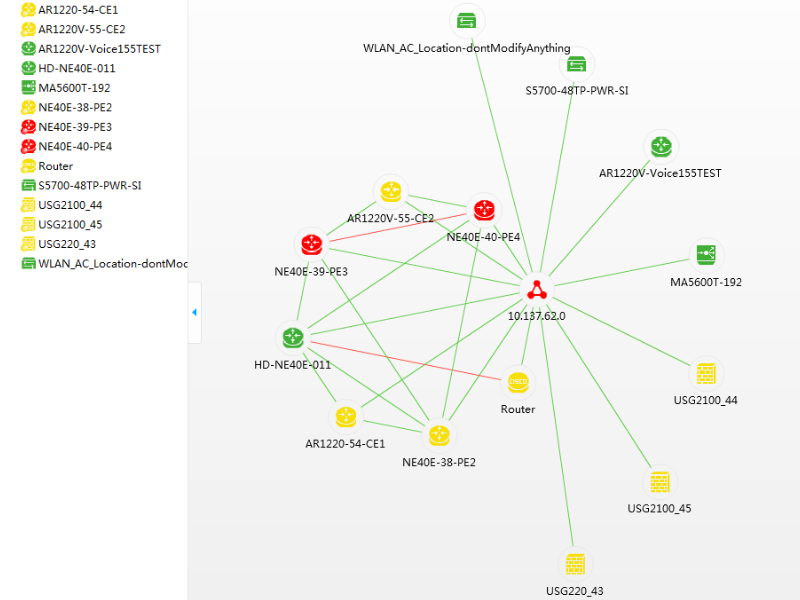| Simplified visual interfaces |
Huawei’s exclusive Super Virtual Fabric (SVF) technology transforms management by core, aggregation, or access switch into management of one virtual, visualized switch, simplifying O&M and accelerating response time |
| Smart, segmented network diagnostics |
- Breaks diagnostics into 12 service segments to simplify management and improve efficiency of O&M personnel
- Performs periodic diagnostics by segment and uses predictive logic to provide warnings before quality issues affect users; quality alerts are displayed visually, enabling quick response
- Fast diagnostics function tests links by segment, narrowing the scope and accelerating fault identification
- Unified visual dashboard displays network performance summaries of services with highest bandwidth utilization, drop rates, matching rates, and excess bandwidth to help monitor QoS metrics and identify exceptions in real time
- Huawei’s proprietary iPCA technology provides end-to-end monitoring of network quality at the device and link levels based on services supported, helping administrators quickly locate link faults
|
| Network terminal management |
- Monitors Access Terminals (ATs) and maintains detailed logs of ATs accessing the network; supports queries of switch administrative interfaces to view terminal access statistics by MAC or IP address
- Provides manual and automated deployment, configuration, and management capabilities — including batch terminal access and version upgrade capabilities — to improve management responsiveness and save time
- Maintains configuration records of IP address, MAC address, PORT-IP, PORT-MAC, and IP-MAC rules for valid network terminals; records detailed information about unauthorized terminals; sends email alerts with detailed information for investigating unauthorized access
|
| Security center |
- Comprehensive, unified security management across the entire network, including Huawei Unified Threat Management (UTM) systems, Unified Security Gateway (USG) series firewalls, and Access Routers (ARs); also supports standards-based 3rd-party devices
- Simplified workflows and graphical interfaces for provisioning security polices and permissions on network devices, storage, cloud-based infrastructure, and applications
- Powerful threat management and risk assessment features — continually enhanced and updated — include security risk analysis, policy redundancy analysis, and policy matching analysis
|
| MPLS VPN management |
- Wizard for fast provisioning and managing of VPN services; End-to-End (E2E) deployment capabilities let administrators quickly provision new VPN services, add VPN access points, and change existing services
- Visual, topology-based management screens display services, bandwidth data, and alarms graphically, giving administrators the ability to monitor the entire network in a unified, consistent manner in real time
- Auto discovery of networks, devices, and services — detects network and subnet topologies, devices and permissions to ensure accurate, up-to-date views for VPN management
- One-click fault diagnosis pinpoints faults at different network layers, helping administrators quickly take corrective action
- Monitors MPLS tunnels in real time, dynamically presenting operating and performance status, including link bandwidth, link interface details, and MPLS support on connected devices to help administrators identify and resolve tunnel faults
|
| IPSec VPN management |
- Automatically discovers and updates IPSec VPN services of all or specified devices to maintain accurate, up-to-date information regarding tunnel setup, operational status, alarm history, encrypted service data direction, and packet loss data
- Displays data in useful visual form for operations, maintenance, and trouble-shooting; displays detailed causes of IPSec VPN service faults (for example, a failure to activate a service), and accordingly locate and rectify faults
- Tightly integrated with other eSight components and reporting features for efficient provisioning and management of IPSec VPN services
|
| Intelligent batch configuration |
Supports batch-mode provisioning and configuration upgrades for common services; deliver standard config files or differentiated configurations when needed or at scheduled maintenance times |
| Configuration file management
|
Maintains configuration files, change histories, and backup files for easy comparison, restoral, and management; provides notification of successful backups |
| Network reports |
- Flexible reports designed to make data useful, from views for top management to detailed performance and resource utilization statistics at the regional, subnet, and NE level
- Provides unified views and formats for converged wired and wireless IP networking based on dozens of standard templates for reporting network performance, utilization, alarms, SLA faults, and QoS metrics in useful views
- Supports easy customization; modify templates for specific times, time intervals and ranges, conditions (faults/failures/performance thresholds), NEs, services, etc.; or create entirely new templates and reporting formats to your exact specifications
- Presents network statistics in multiple views for effective network management: NEs in spatial topology, top N rankings, interface statistics, device resource utilization, WLAN resource utilization
- One-click export functions get reports to other applications — MS Word, Excel — and into PDFs including charts and figures; also supports automated emailing of reports to users at specified times or intervals
|









